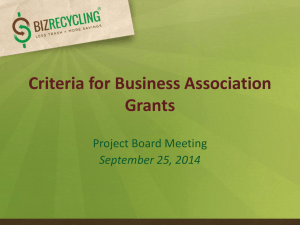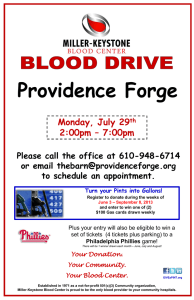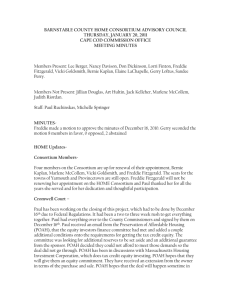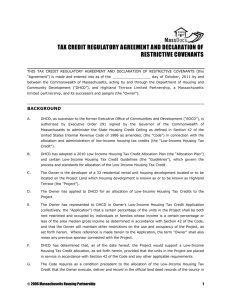Ivy City/Trinidad Neighborhood Stabilization Initiative
advertisement
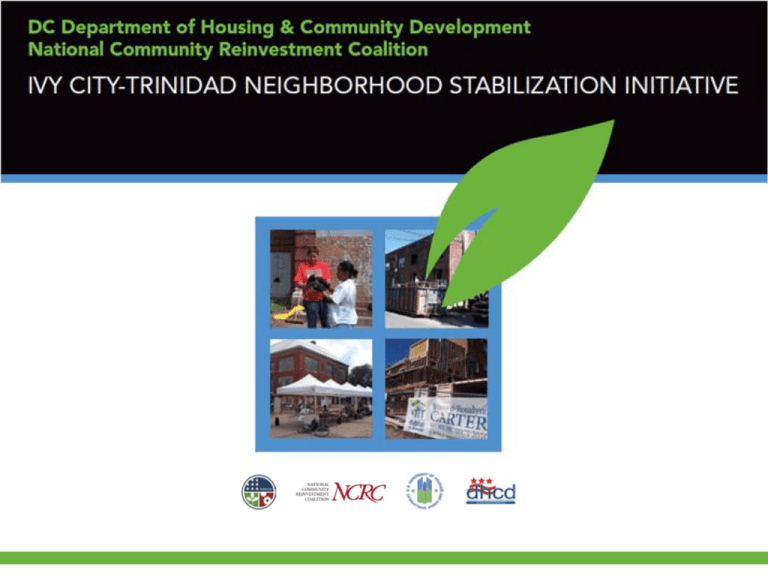
Presentation Outline • Initiative Overview • Ivy City-Trinidad Investment Area Boundaries • Initiative Goals and Objectives • Expected Outcomes • Initiative Activities • Community Engagement Goals • Opportunities for Resident Involvement • Contact Information Initiative Overview The DC Department of Housing and Community Development (DHCD) and the National Community Reinvestment Coalition (NCRC) are building on ongoing initiatives to develop a comprehensive strategy to address housing challenges in the Ivy City and Trinidad neighborhoods. Looking beyond developing affordable places to live, the community engagement process will examine how DHCD’s housing investment can be leveraged to: • Create jobs and a workforce suited to a green economy; • Support small business development and growth; and • Build livable and sustainable communities. Ivy City/Trinidad Investment Area Boundaries Investment area composed of the following census tracts: 79.01, 79.03, 85, 88.02, 88.03, 88.04, 89.03, and 89.04 Ivy City/Trinidad Investment Area Boundaries • One of DHCD’s primary goals in choosing a target neighborhood was to build on other initiatives to maximize the impact of available funds. On-going and past efforts in the Ivy City/Trinidad area include: – – – – – • The Ivy City Special Demonstration Project Jimmy Carter Day/Habitat Week (October 2010) Ivy City Day – Spring 2010 Crummell School Highway Plan Removal HUD criteria also contributed to shaping the exact boundaries. These criteria focused on foreclosure and vacancy rates but also looked at other housing market, credit, and employment needs. Expected DHCD Investment Outcomes The HUD NSP2 grant will allow DHCD to make the following investments across the three target neighborhoods: • Acquire approximately 25 abandoned or foreclosed properties and resell them to low- and moderate-income families • Provide loans for the rehabilitation of approximately 40 multifamily or single family housing units to be rented or sold to low- and moderate-income families • Provide home purchase assistance to approximately 45 low- and moderate-income families to help them purchase homes within the NSP2 communities Initiative Goals and Objectives • Facilitate comprehensive, meaningful community engagement through resident surveys, workforce skills assessments and a series of public meetings to identify housing and economic development priorities and inform investments under NSP2 and future federal grants • Direct DHCD investment to housing projects with the greatest potential to contribute to neighborhood stabilization in accordance with the community’s input and vision for the future. • Ensure that community assets are leveraged to their maximum potential, principally for the benefit of existing residents. • Identify opportunities for neighborhood greening, including cost-saving green infrastructure and residential building enhancements, green workforce training programs and support for local green business development. • Ensure community residents benefit from DHCD investments through the creation of more effective local hiring programs and the identification of needed housing, retail, banking, workforce development and other social services that may be addressed through NSP2. Expected NCRC Planning Outcomes NCRC will build upon and enhance the City’s direct housing investment with a comprehensive housing and economic development approach that is community-led and market-driven and aims to anchor existing residents to their communities, empowering residents to expand their economic opportunities, and enabling them to participate more fully in the process of neighborhood renewal. With this approach, NCRC will inform DHCD’s investment through: • Strategies to optimize homeownership opportunities and maintain housing affordability for existing residents • An analysis of the existing commercial market and recommendations for future business development, including the identification of alternative business ownership models that benefit local residents • The identification of job creation opportunities and an assessment of resident employment skills and existing job training programs • The consolidation of existing neighborhood plans and development proposals • The incorporation of resident-identified opportunities and challenges into a shared community vision Planned Initiative Activities • Community Engagement Campaign – hold a series of public meetings, community leadership meetings and focus groups • Data Collection - collect and map detailed data on current housing conditions, including foreclosure information • Access to Financial Services - assess financial institutions accessible to area residents and determine lending patterns through HMDA data analysis • Housing Marketing Analysis – assess the housing market; conduct analysis of potential acquisition sites; identify alternative homeownership strategies • Commercial Market Analysis - conduct a commercial market study that includes an analysis of key sites and a survey of retail needs; identify alternative forms of business financing, including cooperative ownership • Survey of Community Residents - cultivate rich, first-hand perspectives from neighborhood residents describing the socio-economic and overall environmental challenges they face Planned Initiative Activities (Continued) • Neighborhood Conditions Survey - map neighborhood conditions, including community assets, tree coverage, land use, ownership, and vacancies • Environmental Assessment - identify environmental hazards on potential acquisition properties and opportunities for greening within the neighborhood • Reimaged Photographs - produce a series of reimaged photographs to be used in marketing materials to help visualize neighborhood potential • Job Creation Analysis - assess existing skills of neighborhood residents to determine training needs • Community Marketing and Branding - create and execute a targeted marketing campaign to attract potential homeowners and developers • Project-wide Community Outreach and Marketing – provide media outreach, create a website and produce community meeting videos Community Engagement Goals Through public meetings, focus groups and direct surveys, DHCD and NCRC are seeking robust community input related to the activities outlined above. Our goals throughout this process include: • Facilitate the development of a long-term comprehensive vision for Ivy City/Trinidad with input from community residents and stakeholders • Provide residents and stakeholders with the data and resources they need to inform a strategy to achieve the community’s comprehensive vision • Incorporate the community’s vision and strategy into recommendations to inform DHCD’s housing investment through the NSP2 program Opportunities for Resident Involvement ANC 5B Community Stakeholder Kickoff Meeting Sat., Feb. 26th from 10:00 AM to Noon at the Joseph Cole Rec. Center Workforce Development Needs Focus Group Wednesday, March 9 from 6:00PM – 8:00PM at Gallaudet University Housing Impediments and Opportunities Focus Group Wednesday, March 16 from 6:00PM – 8:00PM at Gallaudet University Social Conditions and Neighborhood Services Focus Group Wednesday, March 23 from 6:00PM – 8:00PM at Gallaudet University Commercial and Business Development Focus Group Wednesday, March 30 from 6:00PM – 8:00PM at Gallaudet University Perspectives on Redevelopment Focus Group Wednesday, April 6 from 6:00PM – 8:00PM at Gallaudet University Contact Information National Community Reinvestment Coalition (NCRC) 727 15th Street, NW, Suite 900 - Washington, DC 20005 Michelle Mulcahy, Special Projects Coordinator (202) 383-7705 James Simmons, Planning Analyst (202) 464-2735 E-mail: ivycity.trinidad@gmail.com DC Department of Housing and Community Development (DHCD) 1800 Martin Luther King, Jr. Avenue, SE - Washington, DC 20020 Martine Combal, Manager, PADD (202) 442-7285 Alan Bray, Special Assistant, Office of the Director (202) 442-7273




